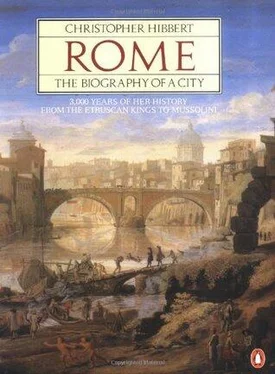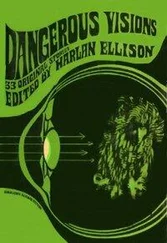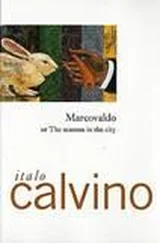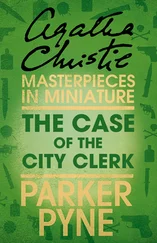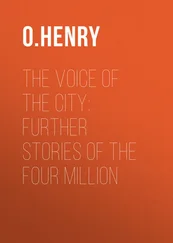Christopher Hibbert - Rome. The Biography of the City
Здесь есть возможность читать онлайн «Christopher Hibbert - Rome. The Biography of the City» весь текст электронной книги совершенно бесплатно (целиком полную версию без сокращений). В некоторых случаях можно слушать аудио, скачать через торрент в формате fb2 и присутствует краткое содержание. Жанр: Культурология, Искусство и Дизайн, на английском языке. Описание произведения, (предисловие) а так же отзывы посетителей доступны на портале библиотеки ЛибКат.
- Название:Rome. The Biography of the City
- Автор:
- Жанр:
- Год:неизвестен
- ISBN:нет данных
- Рейтинг книги:3 / 5. Голосов: 1
-
Избранное:Добавить в избранное
- Отзывы:
-
Ваша оценка:
- 60
- 1
- 2
- 3
- 4
- 5
Rome. The Biography of the City: краткое содержание, описание и аннотация
Предлагаем к чтению аннотацию, описание, краткое содержание или предисловие (зависит от того, что написал сам автор книги «Rome. The Biography of the City»). Если вы не нашли необходимую информацию о книге — напишите в комментариях, мы постараемся отыскать её.
Rome. The Biography of the City — читать онлайн бесплатно полную книгу (весь текст) целиком
Ниже представлен текст книги, разбитый по страницам. Система сохранения места последней прочитанной страницы, позволяет с удобством читать онлайн бесплатно книгу «Rome. The Biography of the City», без необходимости каждый раз заново искать на чём Вы остановились. Поставьте закладку, и сможете в любой момент перейти на страницу, на которой закончили чтение.
Интервал:
Закладка:
5. Paid for by the Prince Regent of England and commissioned by Pius VII on the advice of Cardinal Consalvi, who owed his advancement largely to Henry Benedict Stuart, Cardinal of York, Canova's MONUMENT TO THE STUARTS in ST PETER'S was erected in 1819. It commemorates the Old Pretender, the soi-disant ‘James III’, the Young Pretender, ‘Charles III’, and the Cardinal of York, ‘Henry IX’, who died in Rome in 1807.
6. Pauline Bonaparte, Napoleon's pretty and flirtatious sister, married Prince Camillo Borghese as her second husband in 1803. Canova's statue portrays her as Venus Victrix reclining on a couch with an apple in her hand. This pose and the nakedness of her breasts were her own idea and embarrassed the sculptor who had not wanted to reveal so much of his distinguished model. When she was asked how she could have brought herself to pose almost in the nude, she replied that it had not worried her at all: there was a stove in the studio.
7. The CASINO OF THE VILLA GIUSTINIANI-MASSIMO stands just north of the Piazza San Giovanni in Laterano between the Via Tasso and the Via Boiardo with its entrance at No. 16 Via Boiardo. It was frescoed by the Nazarenes for Prince Camillo Massimo between 1821 and 1829. The reliefs, busts and medallions on the façade are in the style of Vasanzio, Pirro Ligorio and Borromini.
8. The park of the VILLA LUDOVISI covered a large part of the ancient GARDENS OF SALLUST in the area of the present Via Ludovisi between the Via Vittorio Veneto and the Via di Porta Pinciana. It was the property of Cardinal Lodovico Ludovisi, nephew of Pope Gregory XV (1621–3). The main building, by Domenichino of Bologna and Maderno, was demolished when Prince Boncompagni-Ludovisi sold most of the property for development in 1886. The palazzo by Gaetano Koch which took its place was completed in 1890. It became the residence of Queen Margherita and, after the Second World War, the AMERICAN EMBASSY. Within the present, greatly reduced, estate there still exists the Casino which contains, on the ceiling of the gran salone , Guercino's masterpiece, the Aurora of 1621.
The BRITISH EMBASSY by the Porta Pia in Via XX Settembre was designed by Sir Basil Spence after its predecessor had been blown up by Israeli terrorists in October 1946. The British ambassador's residence is the Villa Wolkonsky. Its grounds between the Via Statilia and the Via G. B. Piatti contain some fine remnants of the Neronian Aqueduct which brought the waters of the Claudian Aqueduct from Porta Maggiore to the imperial palace on the Palatine.
16. ROYAL ROME
1. The VILLA NEGRONI was situated between the VILLA MONTALTO and the BATHS OF DIOCLETIAN in the area of the present TERMINI railway station.
2. The PROTESTANT CEMETERY, or CIMITERO DEGLI INGLESI, lies close to PORTA S. PAOLO beside the PYRAMID OF CAIUS CESTIUS, a rich praetor who was buried beneath it in about 12 B.C. Until late in the eighteenth century the bodies of non-Catholics, with the exception of Jews, were taken out of Rome for burial. Several were interred in the waste ground beneath the section of the AURELIAN WALL into which the Pyramid of Cestius had been incorporated. At the time of Keats's death in 1821, negotiations were in progress with Cardinal Consalvi, Pius VII's Secretary of State, for the creation of an enclosed cemetery. Keats's body, and, later, that of his friend, Joseph Severn, were buried in what became known as the Old Cemetery. The adjoining, cypress-shaded New Cemetery contains, among others, the tombs of Shelley and his friend, Trelawney; of Goethe's illegitimate son, Julius Augustus, who died in 1830; of the American sculptor, William Wetmore Story; of John Addington Symonds, the historian of the Italian Renaissance; of R. M. Ballantyne, the writer of boys’ adventure stories. Some Italians are also buried here, including Antonio Gramsci, the first leader of the Italian Communist Party.
Beyond the Via Sabaglia is the British Military Cemetery which contains the graves of some four hundred British soldiers who died in and around Rome in the Second World War. It lies beneath MONTE TESTACCIO, a mound formed by shards of amphorae which were broken when they were unloaded from barges calling at the nearby river port, the Emporium, to discharge their contents of oil, wine and grain.
3. The PALAZZO CAETANI in the Via delle Botteghe Oscure was built in about 1564 to the designs of Bartolommeo Ammanati for Alessandro Mattei, Duke of Paganica. It was later acquired by the Negroni family before passing into the hands of the Caetani. The nearby church of S. CATERINA DEI FUNARI was founded in the twelfth century and rebuilt in the sixteenth by Guido Guidetti. The area takes its name either from a local family or from the rope-makers, funari , who carried on their trade here. The Via delle Botteghe Oscure is so called after the dark shops which formerly existed in the street and which medieval traders inserted into the arches of the THEATRE OF CORNELIUS BALBUS erected in 13 B.C. It was believed until recently that these shops had been built into the CIRCUS FLAMINIUS, but archaeological research has now placed the circus closer to the Tiber. The Via delle Botteghe Oscure has been considerably widened so that the name is no longer appropriate.
4. The CONVENT OF S. SILVESTRO IN CAPITE adjoined the church of S. SILVESTRO IN CAPITE. The church was completed by Pope Paul I in 761 on the ruins of a Temple of the Sun erected by the Emperor Aurelian. It was one of Rome's ancient diaconiae . After the addition of the campanile in the thirteenth century, a design for a new church was submitted by Francesco da Volterra. Building began in 1593, shortly before Volterra's death. He was succeeded by Carlo Maderno who slightly modified Volterra's plans. The new church was consecrated in 1602. Redecoration began in 1680 under the direction of Carlo Rainaldi and was continued after his death by Mattia and Domenico de' Rossi and Lodovico Gimignani. The church originally contained an oratory kept by Greek monks who claimed to preserve here the head of St John the Baptist; hence the addition of capite to the name. In 1885 the church was handed over to English Pallottini fathers and became the church of the English Catholic community. The neo-Gothic Anglican church of All Saints, at 153 Via del Babuino, is by the English Victorian architect G. E. Street who also designed the American church of St Paul's at 58 Via Napoli. St Paul's was built in the Romanesque style in 1879 and contains mosaics by Burne-Jones.
5. The PALAZZO MADAMA was built in the sixteenth century by the Medici family and was occupied by both the Medici popes, Leo X and Clement VII, when they were cardinals as well as by Caterina de' Medici, afterwards Queen of France. It was given its present name when it was the Roman palace of Madama Margherita of Austria (see note 14, Chapter 9). The sumptuous three-storeyed Baroque façade, completed after much delay in 1649, is by Lodovico Cardi and Paolo Maruscelli. The palace has been used as the Italian Senate since 1871.
6. The buildings around the OSPIZIO DISAN MICHELE included a housing estate, arts and crafts schools, a hospice for vagrant children and a reformatory for prostitutes.
7. The original TERMINI railway station was completed in 1876. The impressive modern building which replaced it was begun before the Second World War to the designs of Angiolo Mazzoni del Grande, who was responsible for the lateral buildings, and completed in 1950 by the construction of its striking façade and foyer by Eugenio Montuori, Annibale Vitelozzi, Massimo Castellazzi and Vasco Fadigati, assisted by the engineers, Leo Calini and Achille Pintonello.
8. Largely because subterranean springs caused protracted delays in the building operations, it was twenty-two years before the huge and ugly PALAZZO DI GIUSTIZIA, designed by Guglielmo Calderini, was completed in 1911 at the enormous cost of 40 million lire. Although the architect had declared, in response to criticism, that there was no reason why the Palazzaccio, as it had come to be called, should not stand as long as the nearby CASTEL SANT’ ANGELO, it had to be abandoned temporarily in 1970 because it was considered unsafe. The three-storey building, which stands between the Piazza dei Tribunali and the Piazza Cavour, is constructed of large blocks of travertine and is surmounted by a quadriga by Ettore Ximenes. The massive statues along the façade are of renowned Roman jurists.
Читать дальшеИнтервал:
Закладка:
Похожие книги на «Rome. The Biography of the City»
Представляем Вашему вниманию похожие книги на «Rome. The Biography of the City» списком для выбора. Мы отобрали схожую по названию и смыслу литературу в надежде предоставить читателям больше вариантов отыскать новые, интересные, ещё непрочитанные произведения.
Обсуждение, отзывы о книге «Rome. The Biography of the City» и просто собственные мнения читателей. Оставьте ваши комментарии, напишите, что Вы думаете о произведении, его смысле или главных героях. Укажите что конкретно понравилось, а что нет, и почему Вы так считаете.
